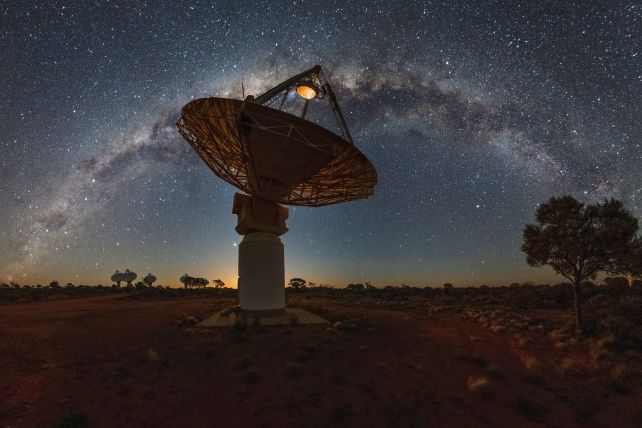Hints of the very first stars to light the Universe might be discovered in a faint radio signal feebly beaming from the dawn of time.
The cosmological 21-centimeter signal emitted by the neutral hydrogen that filled the space between the stars just 100 million years after the Big Bang could have been influenced in ways that encoded the properties of those stars.
We're not there – yet – but observations from a new generation of radio telescope facilities will allow astronomers to tease out the masses of these first stars, a crucial clue to understanding the evolution of the Universe, particularly in its difficult-to-see early epoch.
"This is a unique opportunity to learn how the Universe's first light emerged from the darkness," says astronomer Anastasia Fialkov of the University of Cambridge and the Kavli Institute for Cosmology in the UK. "The transition from a cold, dark Universe to one filled with stars is a story we're only beginning to understand."
Related: Signs of Monster Stars 10,000 Times Our Sun's Mass Found at The Dawn of Time
In the beginning, there was darkness. The tiny, but rapidly expanding, Universe was filled with a hot, dense fog of plasma consisting of small atomic nuclei and free electrons.
As they cooled, these particles came together to form neutral hydrogen and a little bit of helium. But there weren't a lot of stars around, so it stayed pretty dark for a while.

It's from this neutral gas that the first stars are thought to have formed, but, despite our best efforts, we're yet to identify a star from that very first generation of lights glittering in the darkness.
Some astronomers believe that this is because the first stars were absolutely huge, thousands of times the mass of the Sun, with incredibly short lives. Stars this massive would have lived and died in the blink of a cosmic eye.
Such characteristics would make finding them extremely challenging, but they may have left other marks on the Universe. The cosmological 21-centimeter signal is one potential marker: the very, very faint radio light emitted by the interstellar neutral hydrogen in the early Universe as its electrons reversed their spins.
Radio telescopes such as the Square Kilometer Array (SKA) under construction in Australia and South Africa and the Radio Experiment for the Analysis of Cosmic Hydrogen (REACH) in South Africa will be powerful enough to observe this faint signal. When they do, new research has shown them what to look for to find evidence of the first stars.
In a research effort led by astrophysicist Thomas Gessey-Jones of Cambridge and the Kavli Institute for Cosmology, scientists modelled the 21-centimeter signal, and found that the first stars would have had a detectable, and measurable, effect on it.
Not only that, the research showed what that effect would look like – so that, when the observations do come in, scientists will know what it is they have found.

"We are the first group to consistently model the dependence of the 21-centimeter signal of the masses of the first stars, including the impact of ultraviolet starlight and X-ray emissions from X-ray binaries produced when the first stars die," Fialkov says.
"These insights are derived from simulations that integrate the primordial conditions of the Universe, such as the hydrogen-helium composition produced by the Big Bang."
When massive stars die, their cores collapse under gravity and evolve into the densest objects in the Universe: neutron stars and black holes. These extreme objects produce powerful X-radiation that can have a profound effect on material around it.
The researchers say that previous work modeling the effect of the first stars on the 21-centimeter signal did not account for this X-radiation.

The modeled results may not be exactly the same as the observed signal – but the work brings astronomers closer to finding it.
"The predictions we are reporting have huge implications for our understanding of the nature of the very first stars in the Universe," says astronomer Eloy de Lera Acedo of Cambridge.
"We show evidence that our radio telescopes can tell us details about the mass of those first stars and how these early lights may have been very different from today's stars."
The research has been published in Nature Astronomy.
